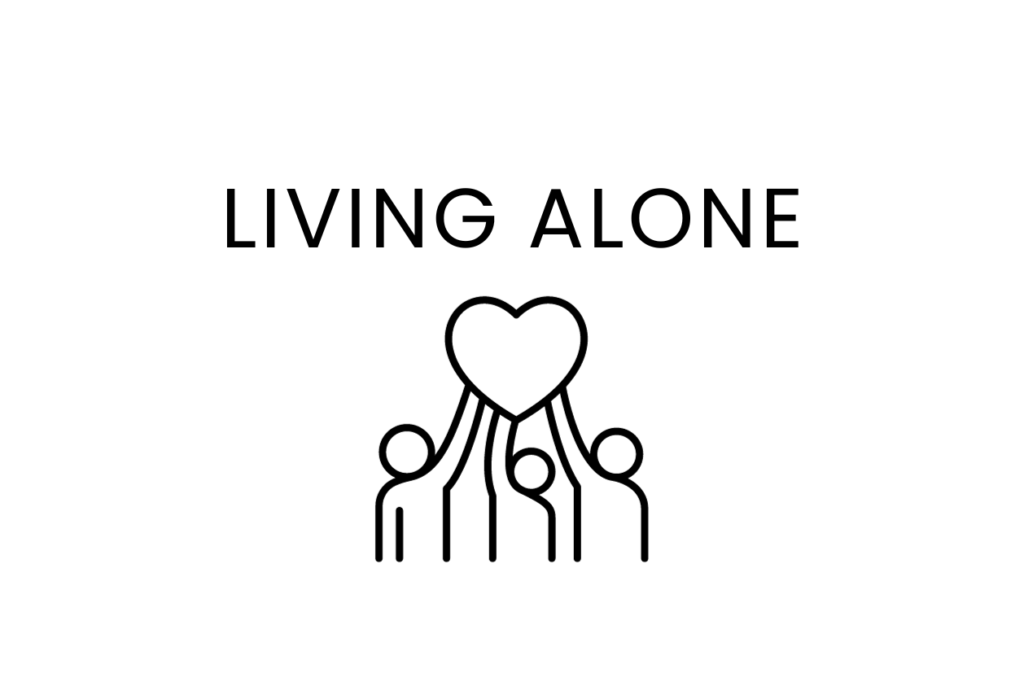Mia, Editor-in-Chief of Body+Mind magazine, shares some tips on setting boundaries with family members when you’re single and living alone.
Navigating questions about being single can be a challenge when dealing with family members. Nosy relatives may persistently inquire about your romantic status, including when you plan to settle down, get married, and have children.
Setting Boundaries With Family Members
Wellness | 17th April 2023 by Mia Barnes
Mia, Editor-in-Chief of Body+Mind magazine, shares some tips on setting boundaries with family members when you’re single and living alone.

Navigating questions about being single can be a challenge when dealing with family members. Nosy relatives may persistently inquire about your romantic status, including when you plan to settle down, get married, and have children.
While some may find these topics enjoyable to discuss, others may feel uncomfortable and prefer to keep their personal life private. It’s important to remember that everyone has different goals and priorities in life, and being single is as valid as any other lifestyle choice.
However, communicating your lifestyle, whether it is borne through choice or circumstance, to family members may be difficult, as they may not understand or respect your decision or situation. It’s not uncommon for some family members to pressure loved ones into relationships or to question their life choices, causing tension and discomfort. This is where setting boundaries becomes crucial.
If you find yourself struggling to communicate your boundaries to your family, there are a few ways to make the conversation easier. You can express your needs and limits in a kind and respectful manner, explaining you would appreciate their support in respecting your decision to remain single. It’s also important to emphasise that you value your relationship with them but that you need their understanding and respect for your choices. With open and honest communication, you can maintain a healthy relationship with your family while staying true to yourself.
7 Ways to Set Boundaries With Family Members
1. Openly communicate stress levels
Open communication about stress levels can help improve understanding and support between family members. While it’s understandable to want to keep some aspects of your life private, sharing certain information about how you’re feeling can help your family members better understand your situation. For example, sharing some information with family; for example, if you’re feeling stressed about work or travelling alone in difficult weather conditions, letting your family know can help them recognise other dimensions of your life where you might need their support.
Additionally, it’s important to let your family members know how their actions or words may be contributing to your stress levels. If questions about your relationship status or other topics are causing you anxiety, it might be helpful to communicate this in a clear and honest manner. While it may be uncomfortable to share these feelings, it’s better to address the issue now rather than let it fester and potentially cause greater strain in the future.
By openly communicating your stress levels and the factors contributing to them, you can help your family members better understand your needs and limitations. This can possibly lead to more supportive and respectful relationships and may even help alleviate some of the stress you’re experiencing. Remember, it’s okay to set boundaries and prioritise your mental and emotional wellbeing, even if it might mean saying no to certain family events or activities.
2. Anticipate your triggers
Being aware of your triggers when spending time with family members can help you prepare for potentially challenging situations. While you may not be able to control the actions or words of others, you can take steps to anticipate and manage your reactions.
One way to do this is by politely requesting that your family members avoid certain triggers or topics of conversation. For example, if you know that discussions about your love life are a sensitive topic, you could let your family know that you would prefer not to discuss it. If, for instance, alcohol consumption is a trigger for you, you could ask that it not be present at events you attend. If this is not possible, you could consider sitting out of the event or finding a way to participate that doesn’t involve alcohol.
While it can be difficult to set boundaries with family members, it’s times like these when it is important to prioritise your own wellbeing. By taking care of yourself, you’ll be better equipped to engage in positive relationships with your family members in the long run. Your loved ones may not understand your perspective at first, but by consistently asserting your boundaries, they may eventually come to respect and accommodate them.
Remember that it’s okay to put yourself first and prioritise your own mental and emotional health. While setting boundaries and anticipating your triggers can take time and be challenging, it’s an important step in taking care of yourself and making an effort to maintain positive relationships with your family.
3. Give yourself permission to set boundaries
Setting boundaries can be a difficult task, especially if you are a people pleaser and you’ve spent your life putting the needs of others above your own. You might feel that by setting boundaries around your lifestyle choices, you will be disappointing your family in some way. While it may feel uncomfortable at first, giving yourself permission to set boundaries can be an empowering and liberating experience.
Further, life as a single person, even through choice, might feel overwhelming to navigate without the constant support and reassurance of a partner. However, by learning to trust and rely on yourself, you can develop a strong sense of self-worth and confidence in your decisions. Standing up for yourself and setting boundaries will not only improve your mental health but will also help you build stronger and healthier relationships in the long run.
Don’t forget that setting boundaries is not about being selfish or dismissing the needs of others. Rather, it’s about finding a healthy balance between meeting your own needs and respecting the needs of those around you. By communicating your boundaries in a clear, consistent and respectful manner, you can establish mutually beneficial relationships that take care of the wellbeing of all parties involved.
While setting boundaries may be a difficult prospect at first, it’s a skill that can be developed with time and practice. Remember, you deserve to be treated with respect and kindness, and setting boundaries is a powerful way of advocating for yourself and taking control of your life.
4. Show appreciation when family respects boundaries
When it gets to this stage, it’s important to recognise and acknowledge when family members respect your boundaries. Showing appreciation can strengthen your relationship and encourage them to continue respecting your boundaries in the future. When someone respects your boundaries, it’s a sign that they care about you and your wellbeing and shows they want to maintain a positive relationship with you.
Expressing your gratitude can be as simple as saying ‘thank you’ and letting them know how much their respect means to you. Writing a thoughtful note or sending a small gift will be a sign and token of your appreciation. Remember, showing gratitude is not about rewarding your family members, but rather, it’s about acknowledging and valuing their efforts to respect your boundaries.
If you’ve been in little to no contact with your family, taking the time to visit them can be a powerful way to show your appreciation. This can demonstrate how much you value your relationship with them and are willing to make an effort to maintain it. However, it’s important to communicate with them beforehand to ensure that the visit is a positive and respectful experience for everyone involved.
Overall, showing appreciation when your family members respect your boundaries can foster a positive and healthy relationship with them. It’s an important part of the process to recognise the efforts of others and communicate your gratitude in a way that feels authentic and meaningful to you.
5. Make plans to see family
You may have set boundaries because someone in your family has disrespected your wishes. If you want to give them another chance, setting a date when you see one another again is a good first step and might make them more receptive to your boundaries.
One of the most difficult parts of setting boundaries might be your desire to give in to appease relatives if you are not on good terms with them. If you talk to your family frequently, you’re more likely to see them at some point. It can be tempting to give in to their requests, but if you communicate your boundaries effectively, your family members should begin to respect them if they are willing and want to help repair relationships. However, it’s also essential to make a plan together for the visit that considers everyone’s needs.
By making plans to see them, you can alleviate some of the pressure and stress that comes with setting your boundaries when you are around them. Making plans around your visit can also give the situation with your family some hope. Fingers crossed, they will appreciate your efforts and the time and resources you put into arranging a visit. A well-planned visit can give you and your family something to look forward to, and, in the hope, you can improve your relationships with them.
Setting a date for a future visit can also help to restore trust and build stronger relationships with your family. By taking this step, you’re demonstrating a willingness to forgive and move forward while still maintaining your boundaries. It also gives your family members the opportunity to show they understand your boundaries and are willing to work with you to maintain them. When everyone is on board, this can help restore trust and build stronger relationships with your family.
6. Unannounced visits
Living alone and living a single life can be a wonderful way to enjoy your independence and personal space. However, if family members frequently drop by unannounced, it can disrupt your routine and make you feel intruded upon. To address this issue, it’s important to establish clear boundaries and communicate your needs. Explain to your family members why their behaviour bothers you and ask for the privacy you deserve and need.
Help your family members understand your perspective by framing your concerns in ways that relate to them. Be patient but firm with your requests for space and privacy.
7. Learn to say no
Learning to say no can be a valuable skill for maintaining your boundaries and preserving your own needs. By setting healthy boundaries and being assertive in saying no, you can protect your time, energy, and resources. While it can be challenging to say no at first, with practice, you’ll become more confident in asserting your own needs. Don’t be afraid to say no when necessary and at times when you need to make yourself a priority.
Setting boundaries is healthy behaviour
Creating and enforcing healthy boundaries is an important aspect of maintaining your own wellbeing and self-respect. Don’t allow anyone in your family to pressure you into giving up your boundaries or to make you feel guilty for asserting your needs.
Recognising and setting boundaries is a sign of strength and self-awareness. By establishing clear boundaries, you’re demonstrating that you value yourself and that you’re capable of advocating for your own needs. This skill will serve you well in all areas of your life. By setting, communicating and asserting your boundaries effectively, you’ll be a more fulfilled individual.
Share this post:
Hear from Solo Living now and then by signing up to our mailing list

























